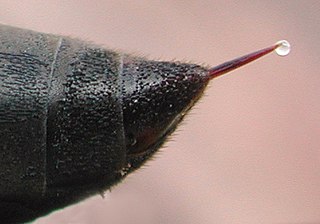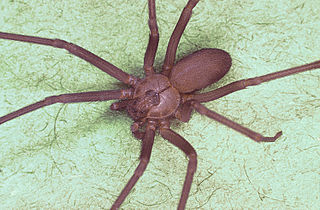
Venom or zootoxin is a type of toxin produced by an animal that is actively delivered through a wound by means of a bite, sting, or similar action. The toxin is delivered through a specially evolved venom apparatus, such as fangs or a stinger, in a process called envenomation. Venom is often distinguished from poison, which is a toxin that is passively delivered by being ingested, inhaled, or absorbed through the skin, and toxungen, which is actively transferred to the external surface of another animal via a physical delivery mechanism.

Sicariidae is a family of six-eyed venomous spiders known for their potentially necrotic bites. The family consists of three genera and about 160 species. Well known spiders in this family include the brown recluse spider and the six-eyed sand spider.

Scyllatoxin (also leiurotoxin I) is a toxin, from the scorpion Leiurus quinquestriatus hebraeus, which blocks small-conductance Ca2+-activated K+ channels. It is named after Scylla, a sea monster from Greek mythology. Charybdotoxin is also found in the venom from the same species of scorpion, and is named after the sea monster Charybdis. In Greek mythology, Scylla and Charybdis lived on rocks on opposing sides of a narrow strait of water.
Tx2-6 is a toxin found in the venom of the Brazilian wandering spider, Phoneutria nigriventer(Keyserling). It is a peptide of 48 residues, molecular weight 5291.3. This peptide is cleaved from a longer precursor with a signal peptide and a glutamine-rich propeptide. It can cause priapism. Tests on rats indicate that the toxin causes nitric oxide release, and its effect on erection is blocked by the nitric oxide synthase inhibitor L-NAME. However, it fully restored erectile function in rats developing hypertension due to injection of deoxycorticosterone acetate. A study is underway at the Medical College of Georgia looking at possible uses for the chemical in erectile dysfunction medication. Scientists and Gregory Ochs are collaborating on this study.

Agatoxins are a class of chemically diverse polyamine and peptide toxins which are isolated from the venom of various spiders. Their mechanism of action includes blockade of glutamate-gated ion channels, voltage-gated sodium channels, or voltage-dependent calcium channels. Agatoxin is named after the funnel web spider which produces a venom containing several agatoxins. There are different agatoxins. The ω-agatoxins are approximately 100 amino acids in length and are antagonists of voltage-sensitive calcium channels and also block the release of neurotransmitters. For instance, the ω-agatoxin 1A is a selective blocker and will block L-type calcium channels whereas the ω-agatoxin 4B will inhibit voltage sensitive P-type calcium channels. The μ-agatoxins only act on insect voltage-gated sodium channels.
Stromatoxin is a spider toxin that blocks certain delayed-rectifier and A-type voltage-gated potassium channels.
Latarcins are short antimicrobial peptides from the venom of the spider Lachesana tarabaevi. Latarcins adopt an amphipathic alpha-helical structure in the plasma membrane. Possible pharmacological applications for latarcins include antimicrobial and anticancer treatments.
Hanatoxin is a toxin found in the venom of the Grammostola spatulata tarantula. The toxin is mostly known for inhibiting the activation of voltage-gated potassium channels, most specifically Kv4.2 and Kv2.1, by raising its activation threshold.
Covalitoxin-II is a peptide toxin that is produced by the spider Coremiocnemis validus. It can induce excitatory, non-lethal behavioral symptoms like quivering and jerking in crickets.
Venom optimization hypothesis, also known as venom metering, is a biological hypothesis which postulates that venomous animals have physiological control over their production and use of venoms. It explains the economic use of venom because venom is a metabolically expensive product, and that there is a biological mechanism for controlling their specific use. The hypothetical concept was proposed by Esther Wigger, Lucia Kuhn-Nentwig, and Wolfgang Nentwig of the Zoological Institute at the University of Bern, Switzerland, in 2002.

Cupiennius salei, from the genus Cupiennius also commonly called the Tiger bromeliad spider, which are large bodied, actively-hunting spiders that are part of the family Trechaleidae.
CSTX is a name given to a group of closely related neurotoxic peptides present in the venom of the wandering spider Cupiennius salei. There are twenty types so far described for this protein group. However, some are reclassified into cupiennins group of toxin, including CSTX-3, -4, -5, and -6, because of their chemical affinity. The first thirteen were isolated and identified in 1994 by Lucia Kuhn-Nentwig, Johann Schaller, and Wolfgang Nentwig of the Zoological Institute at the University of Bern, Switzerland. The different types are most likely the products of splicing variant of the same gene. They are all L-type calcium channel blockers, and also exhibit cytolytic activity by forming an alpha-helix across the cell membrane in mammalian neurons. They also inhibit voltage-gated calcium channels in insect neurons.
Oxyopinins are a group of peptide toxins present in the venom of lynx spiders belonging to the genus Oxyopes, from which they derive their name.
Cupiennins are a group of small cytolytic peptides from the venom of the wandering spider Cupiennius salei. They are known to have high bactericidal, insecticidal and haemolytic activities. They are chemically cationic α-helical peptides. They were isolated and identified in 2002 as a family of peptides called cupiennin 1. The sequence was determined by a process called Edman degradation, and the family consists of cupiennin 1a, cupiennin 1b, cupiennin 1c, and cupiennin 1d. The amino acid sequences of cupiennin 1b, c, and d were obtained by a combination of sequence analysis and mass spectrometric measurements of comparative tryptic peptide mapping. Even though they are not strong toxins, they do enhance the effect of the spider venom by synergistically enhancing other components of the venom, such CSTX.

Oxyopes lineatus is a species of spider in the family Oxyopidae, the so-called lynx spiders.
Oxotoxins, or oxytoxins, are a group of neurotoxins present in the venom of lynx spiders belonging to the genus Oxyopes, hence the name oxytoxin. They are disulfide-rich peptides. Only two types are so far reported from two different species, the larger oxytoxin 1 (OxyTx1) from Oxyopes kitabensis, and the smaller oxytoxin 2 (OxyTx2) from Oxyopes lineatus. OxyTx1, the first known oxytoxin, was discovered in 2002. It was found to enhance the lethal efficacy of the spider venom by acting together with oxyopinins. It is composed of 69 amino acid residue, which are cross-linked by five disulfide bridges. It is a large peptide having a molecular mass of 8059.2 Da; but shows the size of 9,109.4 Da due to the presence of disulfide bridges. It is a potent insecticide, but non-toxic to mice up to 1 μg/20-g mouse. It acts synergistically with oxyopinins of the same venom to increase the insecticidal effect.
AmmTX3, produced by Androctonus mauretanicus, is a scorpion toxin of the α-KTX15 subfamily. The toxin is known for its ability to act as a specific Kv4 channel blocker, and thereby reducing the A-type potassium current through this channel.
Venomics is the large-scale study of proteins associated with venom. Venom is a toxic substance secreted by animals, which is typically injected either offensively or defensively into prey or aggressors, respectively.

Grammostola mechanotoxin #4, also known as M-theraphotoxin-Gr1a (M-TRTX-Gr1a), is a neurotoxin isolated from the venom of the spider Chilean rose tarantula Grammostola spatulate. This amphiphilic peptide, which consists of 35 amino acids, belongs to the inhibitory cysteine knot (ICK) peptide family. It reduces mechanical sensation by inhibiting mechanosensitive channels (MSCs).
The Kalium Database is a manually curated biomedical database on K+ channel ligands found in the venom of scorpions, spiders, sea anemones, cone snails, snakes, centipedes, bees, and more. The first release of the Kalium Database was dedicated to scorpion toxins only, while its second release (Kalium 2.0) included toxins from other living organisms. The most recent update (Kalium 3.0) added information on their artificial derivatives. The Kalium Database is meant to assist structural biologists, toxinologists, pharmacologists, medicinal chemists, and other researchers in their pursuit to develop new drugs for cardiovascular and neurological diseases.






